The internet is everywhere, from the screens in our pockets to giant megaton structures flying in the air or submerged in the ocean. Plenty of these devices let you browse the internet at your leisure, and that we do. In fact, toward the end of 2023, online users worldwide spent an average of six hours and 35 minutes using the internet.1
Table of Contents
As of 2023, the number of online internet users around the worldhttps://newszink.com/2056/pinnacle-10-pointers-to-improve-your-website-visitors/ was estimated to be 5.4 billion2 — or two-thirds of the global population.2 With all of that time spent online, you might be wondering exactly where all that traffic is going. We’ve looked into some of the most fascinating facts and figures to bring you the top website statistics you should know in 2024.

Top Website statistics: Key findings
Here are the key findings from our research on website statistics in 2024:
- According to Netcraft, there are around 1.09 billion websites worldwide.3 There are an estimated 252,000 new websites being created every single day4 — and 93% of all web traffic comes from search engines.5
- The most visited website in the world is Google.6 It processes 5.9 million searches every minute6 and holds 91.54% of the global search engine market.7 Google Chrome holds 64.7% of the worldwide browser market share.8
- YouTube is the most searched term on Google, with over 340 million monthly searches worldwide.9
- In a study done by Semrush, they found that, in 2023, they had 313% more visits on mobile devices than desktops.10 However, sessions are shorter on mobile, with visits lasting on average between 704 and 775 seconds compared to between 996 and 1,918 seconds on desktop.10
- Pages also take longer to load on mobile at an average of 8.6 seconds, while desktop web pages load on average in 2.5 seconds.11 More than half of mobile visits are abandoned if loading takes longer than three seconds.12
How many websites are there?
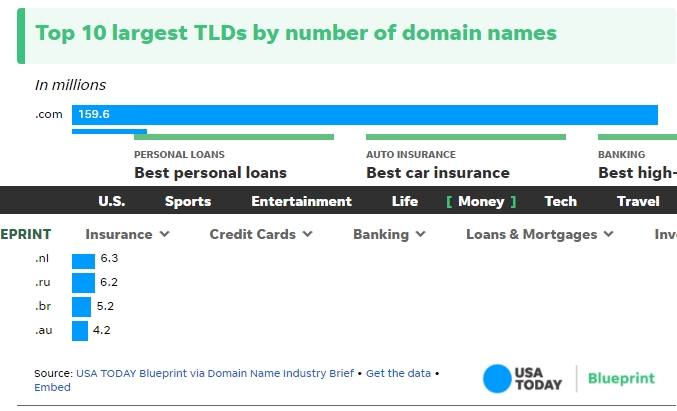
While there are over one billion websites on the internet,3 the vast majority — over four-fifths — are inactive.4 As of April 2023, there were over 30 billion indexed web pages online.4 By the end of 2023, 359.8 million domain names were registered across all top-level domains (TLDs). This number has increased by 2.5% since the end of 2022.13
Speaking of TLDs, the largest of these is the .com domain. There are nearly 160 million domain names using .com.4 The second-largest is .cn with 20.3 million, followed by:4
- .de: 17.7 million.
- .net: 13.1 million.
- .org: 10.8 million.
Looking at languages, over half of all websites (55.6%) are in English.4 Russian is the next most common at 5%, followed by:4
- Spanish: 4.9%.
- German: 4.3%.
- French: 4.2%.
How many websites are created every day?
According to data obtained by Siteefy, there are around 252,000 new websites created every single day, which equates to 10,500 every hour, 175 every minute, or three new websites created every second.4
How many websites use WordPress?
According to W3Techs, WordPress is used on over 43% of websites.14 WPZOOM reports that, as of May 2024, there are more than 474 million sites that use WordPress.15 Looking at the CMS market specifically, WordPress has a dominant 62.8% share.14
With over 30,000 themes and 70,000 plugins available, its flexibility and customization opportunities are a major draw for many web developers.15
To learn more about WordPress and other website builders, read our guide on the best website builders in 2024.
Most visited websites in the world
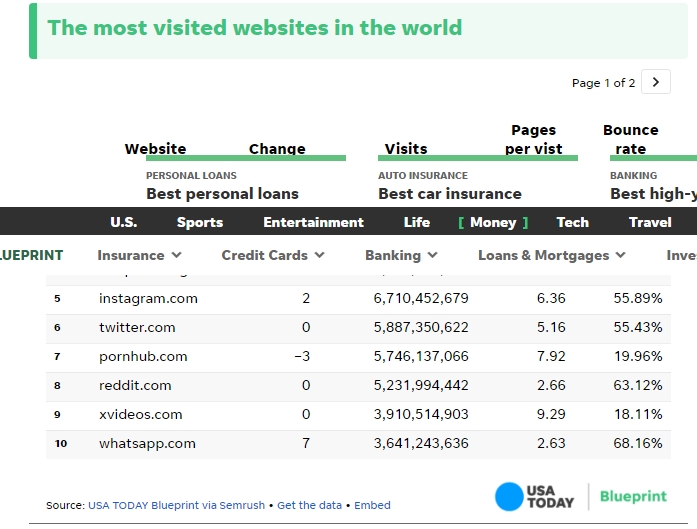
It is no surprise that Google is the most visited website in the world as of March 2024, with many of us relying on it for our day-to-day browsing needs.17 Google had over 136 billion visits in April 2024, with an average of four pages per visit. Its bounce rate is around 42%, and it has an average session of 12 minutes and 11 seconds as of April 2024, according to Semrush.16
YouTube is the second-most visited website in the world as of March 2024.17 It had over 94 billion views in April 2024.18 Facebook followed with over 14 billion views in April 2024.19 YouTube also had the highest session length that month at 23 minutes and 51 seconds on average,18 compared to Facebook’s average of 14 minutes and 6 seconds.19
Most visited websites in the U.S.
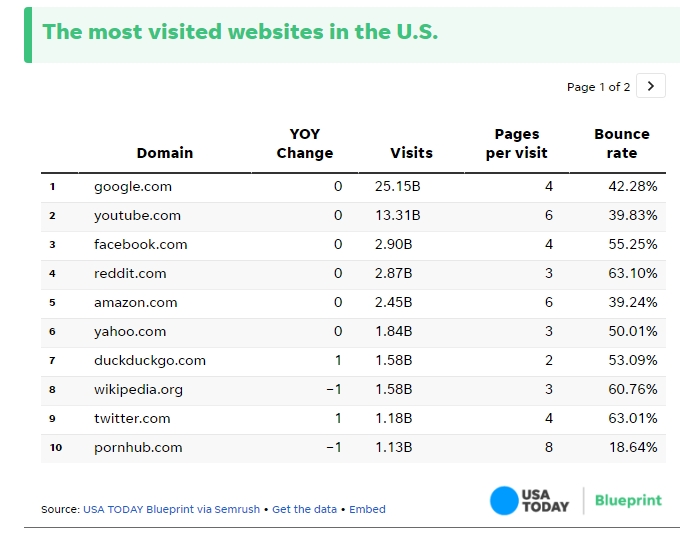
The picture is similar in the U.S. Google is the most visited website, getting over 25 billion views from the U.S. alone in April 2024.20 It’s followed by:20
- YouTube: Over 13 billion views.
- Facebook: Nearly 3 billion views.
- Reddit: Over 2.5 billion views.
- Amazon: Over 2 billion views.
Website traffic statistics
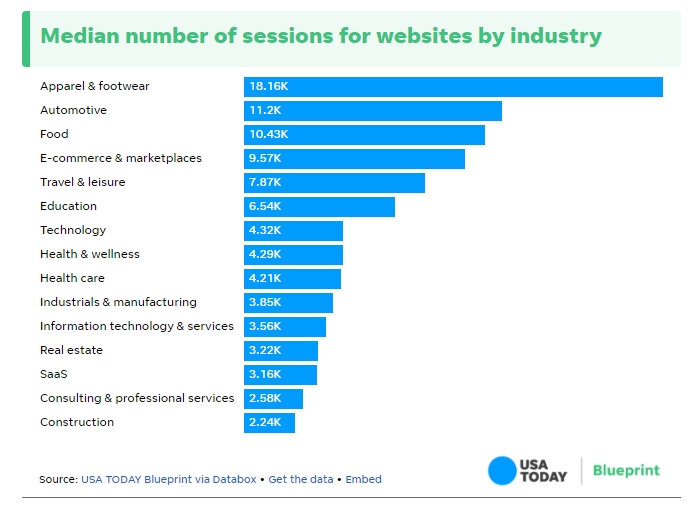
It’s estimated that 96.55% of all online content gets no traffic at all from Google, and around 1.94% only receives between one and 10 visits per month as of 2023.21 When looking at all sources of web traffic, around 22% comes from direct visits to websites, while:22
- 17% comes from organic search.
- 16% comes from social sources.
- 14% comes from email.
- 12% comes from display ads.
At an industry level, while the median number of website sessions for April 2023 was 3.93k across all industries, websites for apparel and footwear are well ahead of any other at 18.16k sessions.23 These were followed by:23
- Automotive websites: 11.2k.
- Food: 10.43k.
- E-commerce and marketplaces: 9.57k.
Reflecting Google’s dominance over the web, around 82% of web traffic analysts who collect and examine such data use Google Analytics, compared to just 25% using HubSpot’s own web analytics platform.22
Website load time statistics
The frustration you feel when a page takes even a few seconds too long to load isn’t just a feeling. It’s a major factor in the number of online sales a business makes. In fact, around 82% of consumers say their purchasing decisions are impacted by slow page speeds.24
To provide some context, just over four-fifths of B2B websites load in five seconds or less, but sites that load in one second have a three times higher conversion rate than one that loads in five seconds.24 The story is similar to that of B2C sites, with those that load in one second converting two and a half times as many visits as sites that load in five seconds.24
The device you’re using can also make a difference. The average web page takes 2.5 seconds to load on a desktop but 8.6 seconds on mobile.11 On average that is 70.9% longer. Research also shows that the likelihood of bouncing — users leaving the webpage — increases by 32% as the load time increases from one second to three seconds.25
Mobile users can be particularly impatient, with over half of all visits on mobile abandoned if pages take longer than three seconds to load. To give an idea of target speeds, the average loading speed for first-page search results on Google is lightning fast at 1.65 seconds.26
The average website bounce rate
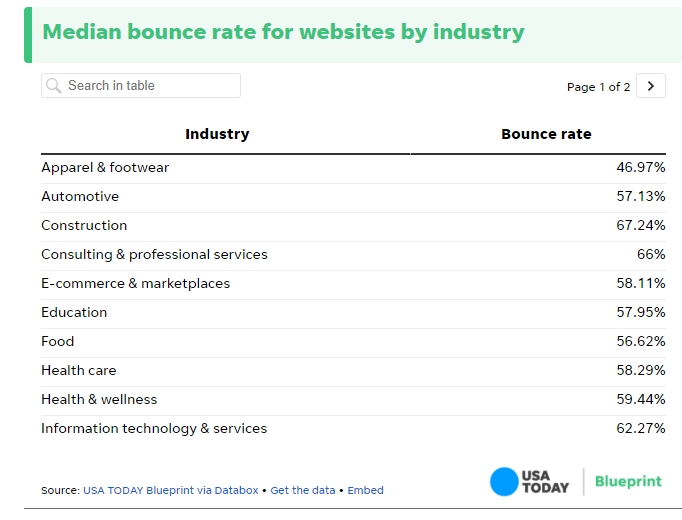
We touched on bounce rates earlier, but as a reminder, the term refers to the percentage of visitors who leave a website after seeing just a single page. This is a good way to measure how effective and engaging your content is.
The median bounce rate across all industries — as of April 2023 — was 60.78%, but once again, apparel and footwear fares the best, with the lowest bounce rate of 46.97%.23 It was followed by:23
- Automotive websites: 57.13%.
- Construction: 67.24%.
Mobile vs. desktop usage in 2024
Desktop vs. mobile vs. tablet market share worldwide
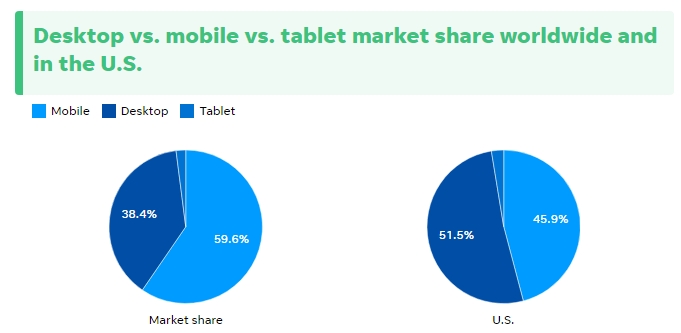
Mobile phones and tablets give users convenient and portable access to the entire world wide web. Accordingly, mobiles have the highest market share of web traffic worldwide at 59.74% (although tablets only have around 2%).10 However, the story is typically different in the U.S., with desktop edging ahead in terms of market share at 51.5% compared to mobile’s 45.9%.27
Based on Semrush data on the top 100 websites worldwide, these websites see 313% more visitors through mobile compared to desktop.10 There were also 233% more unique visits using mobile devices.10
However, 100% more desktop visits resulted in a checkout, and desktop visitors spent 37.7% longer per visit compared to mobile.10 Additionally, bounce rates for mobile visits were also higher at 59.74% compared to 49.8% on desktop.10
Desktop users generally look at more web pages per visit, averaging from just under four to seven pages, compared to mobile users’ average of three pages per session.10 Desktop users also spend longer on websites, with an average session length of between 996 and 1,918 seconds compared to mobile’s lower range of 704 to 775 seconds per session.10
Finally, a zero-click study by Semrush found that 45% of users’ decisions on their next action when Googling something on a desktop occurred within five seconds — but only 33% on mobile.28
Website browser statistics
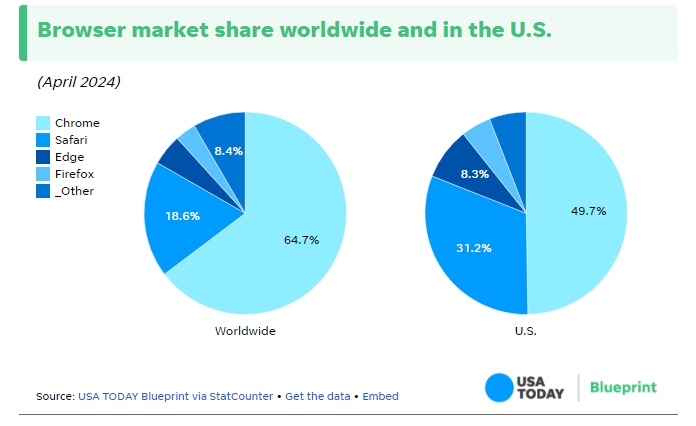
Google Chrome is the world’s most popular web browser, with a worldwide market share of 64.7%.8 It is ahead of:8
- Safari at 18.6%.
- Edge at 5%.
- Firefox at 3.4%.
While the order of browsers is still the same in the U.S., Chrome’s market dominance is significantly lower at 49.7%, just 18.5% ahead of Safari in second.8
Firefox usage stats
While it’s currently the fourth most popular web browser in the world behind Google Chrome, Safari and Edge, Firefox still has an estimated 178 million users.8 Firefox clients use the browser for around five hours a day on average.29
Americans and Russians use it the most at around six and five-and-a-half hours daily usage on average, respectively.29 Users in Italy and India have the lowest daily usage at around 3.7 hours.29
Search engine statistics
Around 93% of all web traffic worldwide comes directly from search engines.5 71% of B2B researchers use a generic search as the starting point for their market research.30
Search engine market share worldwide
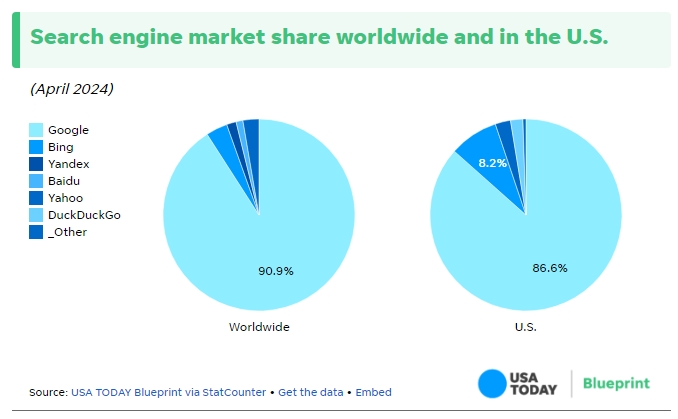
As previously mentioned, Google’s dominance is renowned — it has a 90.9% search engine market share worldwide. Second both worldwide (3.6%) and in the U.S. (8.2%) is Bing. However, Yandex and Baidu take third and fourth worldwide.7
The Russian company, Yandex, has a 1.6% market share worldwide (69.79% in Russia), and the Chinese company Baidu has a 1.2% market share worldwide (66.35% in China).31 Google itself is partially blocked in China after withdrawing from its market in 2010.32
Search engine market share in the U.S.
In the U.S., Google’s dominance is slightly less influential. With a market share of 86.6%, it is followed by Bing (8.2%). The third-biggest search engine is Yahoo, with a 2.6% market share, followed by DuckDuckGo at 2.1%.8
Google search statistics: How many people use Google?
Taking a closer look at Google, the company processes 5.9 million searches every minute.6 Its Google Search index stands at well over 100 million gigabytes and contains hundreds of billions of web pages.33
The majority (63%) of Google searches take place on mobile devices, and only 26% occur on desktops.34 Although the average click-through rate (CTR) for position one on both desktop (22.6%) and mobile (22.4%) is almost identical.35 CTR on mobile devices drops sharply for position two (13%) and even further by position ten with a CTR of 2.3%.35
There are over 35 billion product listings on Google’s Shopping Graph, highlighting its e-commerce influence36 — and businesses receive an average of $8 in profit for every $1 spent on Google Ads.37 In fact, Statista figures show that almost a third of consumers use online search to find local businesses multiple times a week, with over a fifth searching for businesses daily.38
Most popular Google searches
In 2023, the most popular search on Google across the entire world was YouTube, with 340.3 million monthly searches.9 This was followed by:9
- Facebook: 238.5 million.
- Pornhub: 189.8 million.
- Weather: 147 million.
- Amazon: 146.7 million.
Out of all the traffic Google receives worldwide, most of it comes from the U.S., with the country driving 26.95% of its total desktop traffic.39 It is ahead of India (4.52%), Brazil (4.32%), the U.K. (3.92%) and Japan (3.87%).39
Sources
- Statista – Average daily time spent using the internet by online users worldwide from 3rd quarter 2015 to 4th quarter 2023.
- Statista – Number of internet users worldwide from 2005 to 2023.
- Netcraft – April 2024 Web Server Survey.
- Siteefy – How Many Websites Are There in the World?
- Konstruct Digital – Stat: 93% of all web traffic comes from search engines.
- Statista – Online search market worldwide – Statistics & Facts.
- StatCounter – Search Engine Market Share Worldwide.
- StatCounter – Browser Market Share Worldwide.
- Statistia – Most popular keywords on Google search worldwide in 2023, by monthly search volume.
- Semrush – Mobile vs Desktop Use and Trends in 2024.
- ToolTester – Website Loading Time Statistics (2024).
- Think with Google – Consumer Insights.
- Domain Name Industry Brief – The Domain Name Industry Brief Quarterly Report.
- W3Techs – Usage statistics and market share of WordPress.
- WPZOOM – How Many Websites Use WordPress in 2024? WordPress Statistics.
- Semrush – April 2024 Traffic Stats: google.com.
- Semrush – Top Websites.
- Semrush – April 2024 Traffic Stats: youtube.com.
- Semrush – April 2024 Traffic Stats: facebook.com.
- Semrush – Top 100: The Most Visited Websites in the US.
- Ahrefs Blog – 96.55% of Content Gets No Traffic From Google. Here’s How to Be in the Other 3.45% [New Research for 2023].
- HubSpot – How Many Visitors Should Your Website Get? [Data from 400+ Web Traffic Analysts].
- Databox – Website Traffic Benchmarks by Industry.
- Portent – Site Speed is (Still) Impacting Your Conversion Rate.
- Think with Google – Marketing Strategies.
- Backlinko – Here’s What We Learned About SEO.
- StatCounter – Desktop vs Mobile vs Tablet Market Share Worldwide.
- Semrush – Zero-Clicks Study.
- Firefox – Firefox Public Data Report.
- Think with Google – The Changing Face of B2B Marketing.
- Statcounter – Search Engine Market Share Russian Federation.
- Comparitech – Is Google blocked in China?
- Think with Google – How Google Search organizes information.
- Google Search Central – Mobile-first indexing has landed – thanks for all your support.
- Semrush – The State of Search 2023.
- Google – Supercharging Search with generative AI.
- Google Economic Impact – Methodology.
- Statista – Frequency of online searches for local businesses according to consumers in the United States as of January 2023.
- Statista – Regional distribution of desktop traffic to Google.com as of December 2023, by country.






